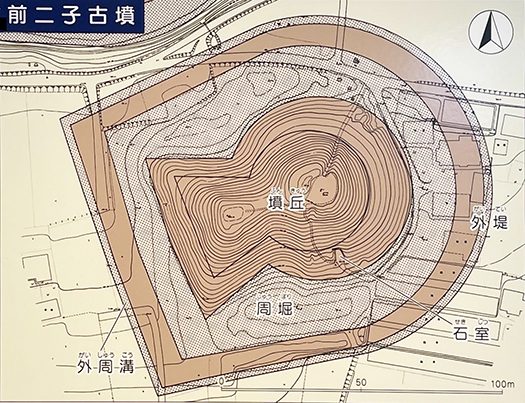


〜日本武尊(ヤマトタケルノミコト)は東国遠征の帰りに亡き妻を思い出し、
東方を向いて嘆き悲しんだ。そして碓日坂においてその東側の土地を
「吾嬬(あづま)」と呼んだ。後になって東海道足柄峠、東山道碓氷峠の坂より
東の地域を「坂東」と呼ぶようになった。〜
この説話の場所についてはいくつかの説があるようだけれど、
古道としての東山道から群馬県から信濃へ抜ける周囲には
「嬬恋」「吾妻」というような地名も残っている。
日本武尊自体も輪郭線のハッキリしない人物だけれど、
ヤマト朝廷の東方領土拡大方針を考えれば、東征という事実はあったでしょう。
しかしそもそも「東」という漢字を訓で「あづま」となぜ読むのか、
これもしっかりとした定説があるわけではないという。う〜む、ナゾは深い。
古事記では日本武尊が相模から上総に渡る際、走水海(横須賀)の神が波を起こし
船は進退窮まった。そこで后の弟橘媛(オトタチバナヒメ)が
自ら命に替わって入水すると波は自ずから凪ぎ、一行は無事に上総国に渡れた。
日本武尊は現在の木更津市にしばらく留まり弟橘媛を思って歌にした。・・・
上写真はJR「大人の休日倶楽部〜大人になったらしたいこと」キャンペーンの
大室古墳を舞台にした吉永小百合さんのポスター。
別に日本武尊の「吾妻」弟橘媛連想ではありません(笑)。
なんとなくあづまという読みの起源にこういうロマンチズムがあるのは
いかにも論理よりも情を優先させる日本らしさも感じられるかと。
由来はともかくとして、その後の日本史の変遷でこういうロマンス譚が
広く普遍化したことの方がきわめて興味深いことかも知れない。
そしてやがて古墳時代に立ち至って、
上毛野氏が群馬県地域支配を確立した。
この上毛野氏の素性を見ていくと、日本武尊の東国制覇譚とも重なる。
いまの堺の街のあたりを始原地とする一族が、
ひたすら東進してきてこの地に勢力を築いている。
前方後円墳といういかにもヤマト王権の勢力拡大を象徴させる「土木建築」装置。
そして山を越えて信濃という東山道の地にも「大室古墳」がある事実。
神話の世界と考古発掘的事実の隘路がおぼろげに証立てられてくる気がする。
大室古墳資料館で、遅れてきたサユリスト(古っ)の部分を刺激された(笑)。
ここでこういう奇襲攻撃があるとは思わなかったので、
まったく不意を突かれておりました。
熟年層の旅行熱を刺激しようというJRの広告戦略はまったく正しい(笑)。
English version⬇
Azumahaya, Tsumagoi of Nihonmuson – Exploring the “Jomono Clan”-2
JR’s advertising strategy of stimulating the travel fever of the mature demographic is correct (laugh). Romance tale in the origin of the kun reading of Azuma. Japanese people put their emotions first. …
〜On his way back from an expedition to the east, Yamatotakeru no Mikoto remembered his deceased wife.
He turned to the east and grieved. He called the land to the east of Usuhizaka
Azuma,” he called the land to the east of Usuhizaka. Later, the area east of the slopes of Ashigara Pass on the Tokaido Highway and Usui Pass on the Higashiyama Highway was called “Banto.
The area to the east of the Tokaido Ashigara Pass and the Usui Pass on the Higashiyama Road came to be called “Banto. ~.
There are several theories as to the location of this story.
There are several theories about the location of this story, but the area surrounding the Higashiyama Pass, which was an ancient road that led from Gunma Prefecture to Shinano, is called
There are also place names such as “Tsumagoi” and “Azuma” in the area surrounding the Higashiyama Road, which runs from Gunma Prefecture to Shinano.
Nihon no Musunon himself is also a man of indistinct outline, but he was a member of the Yamato court.
However, considering the Yamato court’s policy of territorial expansion in the east, there must have been a fact of an expedition to the east.
However, there is a solid theory as to why the kanji for “east” is read as “Azuma” in kun (Japanese).
There is no solid theory as to why the Chinese character for “east” was read as “Azuma” in kun. The riddle is deep.
According to the Kojiki, when the Japanese god Takemikoto crossed over from Sagami to Kamisusa, the god of the sea at Sosui (Yokosuka City) caused the waves to rise up.
The ship was in a difficult situation. The ship was in a difficult situation.
The waves calmed down and the group was able to cross safely to the Land of Kaminoso.
The group was able to safely cross over to Kisarazu, where they stayed for a while and wrote a poem in memory of Ototachibana Ehime.
The photo above is from JR’s “Otona no Himitsu Club – What I want to do when I grow up” campaign.
The photo above is a poster of Sayuri Yoshinaga with Omuro Kofun as a stage.
It is not an association with “Azuma” Otomotachibana Ehime, the Japanese goddess of war (laugh).
Somehow, this kind of romanticism in the origin of the reading “Azuma” is
I think it is a Japanese way of prioritizing emotion over logic.
Regardless of the origin, it is interesting to note that this kind of romance tale became widespread and universal in the course of subsequent changes in Japanese history.
It is perhaps more interesting to note that this kind of romance tale became widespread and universal in the course of subsequent Japanese history, regardless of its origin.
And then, as we come to the Kofun period
The Kamomono clan established control over Gunma Prefecture in the Kofun period.
The Kamimono clan’s background overlaps with the tale of the conquest of the eastern part of Japan by the Japanese warrior warrior Takemikoto.
A clan that originated in what is now Sakai City
The family originated in the area around Sakai, and moved eastward to establish their power in this area.
The “civil engineering” device of a front-recession burial mound symbolizes the expansion of the Yamato kingdom’s power.
And then there is the fact that there is also an Omuro Kofun Tumulus in Shinano, a place across the mountains along the Higashiyama Road.
I feel that the bottleneck between the world of mythology and the facts of archaeological excavation is vaguely evident.
In a place like the Omuro Kofun Tumulus Museum, I was stimulated by my late arrival as a “Sayurist” (laugh).
I didn’t expect this kind of surprise attack here, so
We were caught totally by surprise.
JR’s advertising strategy of stimulating the travel fever of the matured generation is absolutely right (laugh).
Posted on 8月 11th, 2022 by 三木 奎吾
Filed under: 日本社会・文化研究, 歴史探訪







コメントを投稿
「※誹謗中傷や、悪意のある書き込み、営利目的などのコメントを防ぐために、投稿された全てのコメントは一時的に保留されますのでご了承ください。」
You must be logged in to post a comment.